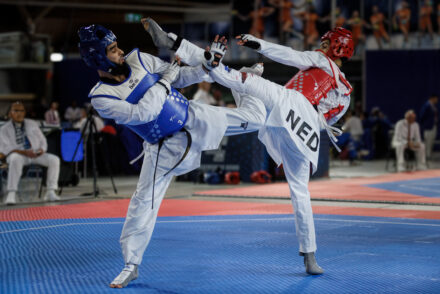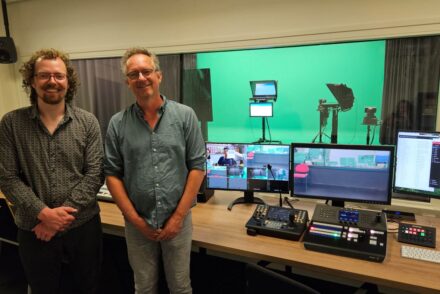Tilburg pre-investments: nearly 8.5 million was not ‘additional’ as promised
It was a wonderful political promise: in exchange for surrendering the basic grant, students would receive significantly better education. To achieve this, all universities and universities of applied sciences had to invest heavily. Now that the loan system will be abolished, the time is ripe to look at what has come of those investments within Tilburg University. Univers figured it out and provides answers in this three-part series. With today the first part: the pre-investments.

Lees dit artikel in het Nederlands.
It is May 2014 when a letter (in Dutch) from Minister Bussemaker is dropped in the mailbox. The sender is the umbrella organization Universities of the Netherlands (UNL), responding to the minister’s intention to implement a loan system for students in higher education. By means of the letter, UNL states that, in return, it expects “even higher quality, more intensive education.” The exchange appears to foreshadow what will become final eight months later: the implementation of the “student loan system” (sociaal leenstelsel). Students who start studying as of September 2015 will no longer be entitled to a grant but will have to borrow instead.
To ease the pain of removing the basic grant, the minister promises to invest the cutbacks in the quality of higher education. However, the problem is that this money, also called the revenues from the student loan system (studievoorschotmiddelen), will only be gradually released as of 2018. This while students start borrowing three years earlier. “More quality should be offered in return immediately,” the UNL said.
The universities and universities of applied sciences decide to act collectively and pledge to jointly invest two hundred million euros annually from their own resources in the years 2015, 2016, and 2017. These additional investments are called the pre-investments and are aimed at immediately strengthening education and everything that contributes to it to some extent. In this way, an improvement in quality can be achieved in the short term, and the first students of the loan system can benefit immediately.
Tilburg University is no exception to this agreement. During this period, it too promises to raise the quality of education to a higher level with additional investments. A legal condition is that the participation council has the right of consent on the main lines of the budget. Lecturers and students can thus have a say in where the money from the pre-investments goes.
The question that arises now – almost eight years after UNL’s letter – is whether Tilburg University has fulfilled this promise. What did the university invest in at the time, and can these expenditures be labeled pre-investments? How exactly did this process take place?
Muddled time
“It was a muddled time.” With those words, Rien Wijnhoven, chair of the University Council since 2014, looks back on the period regarding the pre-investments. “The Executive Board, the officials, and the participation body, everyone was trying to find his/her way.” He said it was due to poor guidance from the Dutch government. “It was never really clear to us what the national spending guidelines were for the pre-investments.”
Jeroen Wienen, party member for SAM in the year 2014-2015, confirms that it was a quest. “While the Board informed us that the legislature had to provide financial frameworks before it could invest, the law was in place in the meantime. Therefore, we wanted to speed up the pre-investment plans. This became a bit of a battle between us and the Board.”
Which is which?
Pre-investments: this is the money that universities and universities of applied sciences invested in the years 2015, 2016, and 2017 in the quality of education for the group of students who had already lost their basic grant as of 2015. Because the money from the basic grant – revenues from the student loan system – did not become available until 2018, this money was used to bridge the gap.
Revenues from the student loan system: this is the money released by the introduction of the loan system and the accompanying abolition of the basic grant. As of 2018, universities and universities of applied sciences receive this money, with the aim of improving the quality of education.
Quality Agreements: these are the long-term plans drawn up by each university and university of applied sciences and contain their concrete objectives and intentions regarding the revenues from the student loan system. These plans must fall under six agreed themes and are reviewed and monitored by the NVAO.
That the conversation about the pre-investments got off to a difficult start is also evident from the University Council’s documents. At the November 13, 2015 meeting, the Executive Board let it be known that it was willing to have a substantive discussion about the pre-investments but not until April 2016. This is about two years after the UNL letter; by then, the first cohort of students without a basic grant had already completed almost a full academic year.
Did the pre-investments get the attention they deserved? “I fear that they got a little snowed under by the subsequent quality agreements,” Mirjam Siesling of the employee party Independents told me. “That’s when things got serious, everyone thought. Everything before that was kind of funneled into the organization.”
‘Additional’ investments
Despite the faltering process, in the 2017 annual report (in Dutch) a table appears that clearly shows the pre-investments Tilburg University has made in the previous three years. In total, the expenditures amount to some 19.1 million euros. Whether all expenditure items are rightly categorized as pre-investments, however, is highly questionable.
It is questionable whether they all fall under “additional” investments, as referred to in the original agreement between the UNL and the minister. According to the UNL website, additional investments are considered to be ‘new plans and existing plans that the universities will now implement sooner and with greater scope.’ Thus, a pre-investment need not be a completely new investment, an addition or bringing a plan forward is sufficient.
Of at least five expenditures in the table – totaling 9.3 million euros – it is known that they had already been planned before 2015 and were, therefore, not new. These are the expenditure items ‘pilots to improve educational quality,’ ‘exceeding the performance agreements regarding study success,’ ‘expansion of UTQ capacity,’ ‘deployment of the BEST’ proceeds.’ and ‘deployment academic staff for education.’ The first four plans were part of the Strategy 2014-2017, which came about in 2013. The last item also dates from 2013, when it was decided to invest 1.4 million in more educational staff (meer handen aan het bord) between 2014 and 2016.
Most of the investments that had already been planned were not increased from 2015. This can be seen in the graph: the budgeted amounts almost all correspond to the realized expenditures. In the case of the University Teaching Qualification (UTQ), the expenditures were even lower overall. Since there is also no evidence that this spending has been brought forward or accelerated, it definitely falls outside the scope as a pre-investment.

The only item of expenditure that is higher than budgeted is the investment of money released by the BEST operation. BEST (Building Excellent Support at Tilburg University) was a reorganization within the university aimed at making the support services more ‘efficient, transparent, and effective.’ The revenues from this were estimated at 5 million but ended up being 860,000 euros more.
Of the 9.3 million euros Tilburg University has put into existing plans, this is the only amount that strictly falls under the definition of a pre-investment. So, the rest – over 8.4 million euros – does not. While the university did declare these as such. Wrongly, as it turns out.
Despite some doubt, for the remaining 9.8 million in expenditures, there is no clear evidence that they had been announced before 2015. As such, they appear to be new and, therefore, additional. These include money that went toward improving assessment quality and the creation of the Jheronimus Academy of Data Science (JADS) in Den Bosch, as well as investments in university infrastructure such as buildings and ICT. Whether these expenditures also contributed substantively to educational quality – as was also a requirement for the pre-investments – is a question that will be addressed in the final article of this research series.
Not to be sustained
The requirement for a pre-investment to be additional was also used in the report (in Dutch) by the Netherlands Court of Audit (Algemene Rekenkamer) that appeared in 2018. This showed that only a third of all investments made by Dutch universities and universities of applied sciences actually qualify as pre-investment. The criterion used led to criticism from universities and universities of applied sciences.
“It’s a standard that can’t be sustained,” says Wijnhoven. “We are supposed to keep it all apart, but of course that’s not how it works in practice. What matters is that the people on the work floor are facilitated and paid. Whether that is with a euro from the pre-investments or from the government grant, they don’t care about that.”
That the Executive Board was caught between theory and practice, Jeroen Aben also recalls. He was a member of the University Council in the year 2016-2017 on behalf of SAM. “It is an enormous task for an educational institution to suddenly make an additional pot of money available in addition to the regular funding and then put a new bow around it. Because you want to connect that amount harmoniously with your current strategy, tension inevitably arises.”

A similar problem arises with the revenues from the student loan system, the released basic grant money that slowly trickled into the university starting in 2018. Finding completely new uses for these euros proves to be difficult as well. “At a certain point, you notice that you can no longer come up with additional things because all the plans for quality improvement already exist,” according to Robin de Hoon, University Council member for Front in the year 2018-2019. “You don’t just pull out a can of 20 new ideas. That’s why I became a little more accommodating toward the Board In time.”
Razor-sharp dividing line
When asked, Tilburg University said that it considered the inclusion of pre-existing educational investments in the pre-investments to be a “responsible practice.” According to the university, “no razor-sharp dividing line” would exist between the period before and after the creation of the pre-investment agreements. Here it refers to a 2015 reply (in Dutch) from the minister at that time to Parliamentary questions, stating that it is “logical and justified” that “these investments (the pre-investments, ed.) take place as an extension of previously made quality plans.” In addition, the same minister informed the House of Representatives that institutions that had previously provided their education with a substantial boost cannot be expected to come up with such a financial injection again.
Due to the lack of clear regulations during that period, Tilburg University has taken these statements by the minister as a guide. From that perspective, the investments already foreseen before 2015 were labeled as pre-investments. The university indicates that this was done with the consent of the University Council and, it says, has always been transparent about this process. That Tilburg University’s qualification of pre-investments is not in line with the Court of Audit’s “stricter” criterion from 2018, according to the university, has to do with the fact that it was only introduced later.
But here is where the shoe pinches: in fact, the same criterion was used by the minister back in 2015. This is evident from that same answer to which the university refers, in which one sentence later the minister says that pre-investment is about “intensifying and accelerating quality plans.” This is no different from the Court of Audit’s definition in which pre-investment is seen as increasing or bringing forward planned investments. So, the new criterion (from the Netherlands Court of Audit) is just as strict as the old criterion (from the minister); both criteria allow an increase in investments that had already been planned. But as mentioned earlier, this amount for the university adds up to only 860,000 euros.
Weather reality
In order to ensure that students and lecturers had a voice in the distribution of the pre-investments, it was legally enshrined at the time that the participation body had the right of consent on the main lines of the budget. A good idea on paper, yet Tilburg University’s reality proved more unruly.
“As a ‘representative’ you can make an impact, but you shouldn’t be under the illusion that being in the University Council is going to change the world,” Wienen explained. “As a small club of Council members, you have to compete against the Executive Board, which has a substantial body of civil servants at its disposal. That’s not necessarily balanced. It is, therefore, a matter of picking your battles.”
University Council Chair Wijnhoven: “It is indeed unrealistic to think that the University Council can be a fully-fledged partner of the Executive Board. If you just count the number of officials who directly support the Board, you end up with well over a hundred. Moreover, they are full-time administrators with years of experience. They are tried and tested.”

The same cannot be said of the inexperienced student participation representatives, who also change every year. Because of this annual change, they lack a collective memory and lose grip on structural processes such as pre-investment. In the words of Sabine Scheffer, student representative for Front in the 2017-2018 year, “As a student Council member, you are mostly busy with your own year and, therefore, have little overview. And by the time you’re just getting comfortable in it, you already have to stop.”
What also does not contribute to the monitoring powers of the central participation council is the limited freedom that members of the University Council experience when it comes to giving its consent or not to the budget. Not giving consent could have far-reaching consequences for the university’s employees and students – no one who wants that on his or her conscience.
“At the time, I supported the content of the projects but was very doubtful that they were covered by the pre-investments. Nevertheless, we agreed to the plans,” Aben admits. “You feel responsible for the continuity of the university after all, which would be at risk if you don’t cooperate. The question is whether you dare to do that.”
Who gets to do what?
So, although the influence of Council members on the budget is limited, the majority of former Council members do feel that they were taken seriously during the pre-investment process. Scheffer: “As a student you should not only have the awareness that you can say something, but you should also have the feeling that you are allowed to say something. You have to dare and not be afraid to get in trouble for saying certain things. That atmosphere was good in my year.”
Aben also feels that the students were well involved in the process, although he says the details were not discussed. “Discussions with the EB were limited to the general terms. As soon as it came to the details, there was little room for dialogue.” It reflects the tension that sits on the interpretation of the right to consent: how far can the participation body go and how do you define those ‘general terms’?
The interpretation of this is still a point of discussion today. “The participation’s right of consent was new to everyone at the time,” said participation member Siesling. “This led to procedural questions about the reactive role the participation normally has. It is a topic that still comes up regularly in the University Council.”
According to Wijnhoven, the lack of clarity about the Council’s powers is indicative of the entire issue surrounding pre-investment. “It is the result of a political change (the introduction of the loan system and the associated promise of educational investment, ed.) that appeared at the speed of lightening. Politicians basically said, ‘look at everything we’re doing.'” Because too few guidelines were subsequently provided, a chaotic atmosphere developed both nationally and within the university – and that did not help the implementation of the pre-investments.
Research series on Tilburg’s basic grant millions
This story is the first part of a three-part series about Tilburg’s basic grant millions. Are you curious to read more? See the other articles on quality agreements and education improvements here.
Translated by Language Center, Riet Bettonviel






